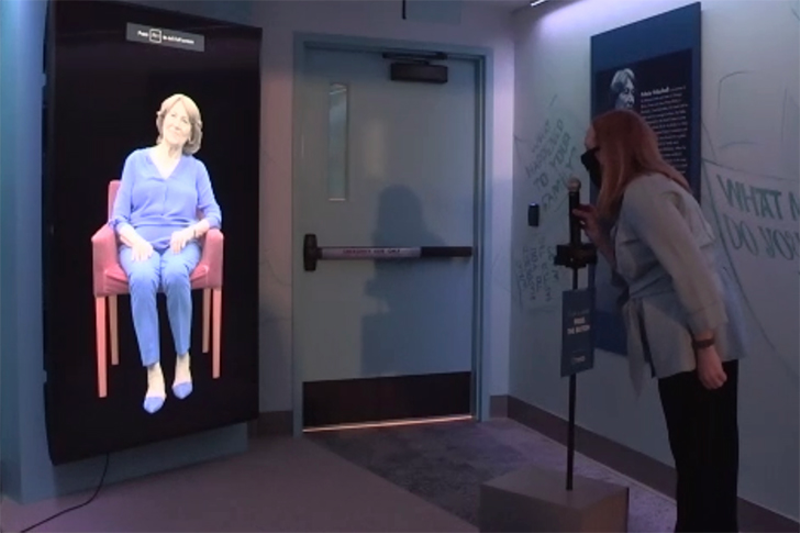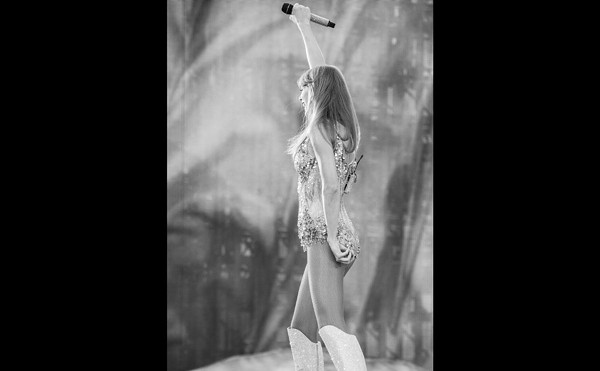Cincinnati Museum Center's Nancy and David Wolf Holocaust & Humanity Center has introduced an innovative way for visitors to closely connect with the experiences of the Holocaust.
The museum held a virtual ribbon-cutting ceremony ahead of the exhibit's Feb. 5 opening, unveiling the new exhibition.
"Dimensions in Testimony" invites attendees to have virtual “conversations” with Holocaust survivors via artificial intelligence.
The opening ceremony featured keynote speakers from the project as well as a demonstration of the interactive exhibit.
According to Sarah Weiss, chief executive officer of the center, the exhibit will permanently preserve the testimony of Holocaust survivors and the interactive nature in which visitors can access this information. While survivors still routinely appear in public spaces to share their stories, there will eventually be a future generation that can no longer hear firsthand accounts of the experiences that millions of Jewish citizens endured.
“This exhibit will help us personalize the history [and] humanize the history for the day when we sadly no longer have eyewitnesses among us,” Weiss said. “Their stories will continue to be told.”
The exhibit features a two-dimensional display of each Holocaust survivor to whom visitors can ask questions and receive appropriate responses in real-time.
Utilizing natural language processing, the exhibit’s system selects keywords in the visitor’s question and searches through the hours of testimonial footage for an appropriate response. A section of the testimony is then played on the display, so the survivor answers the visitor’s question and cultivates a “conversation-like experience.”
The exhibit was developed by the USC Shoah Foundation. According to Stephen Smith, executive director of the foundation, the project intends to preserve the two-sided dynamic between Holocaust survivors and future generations.
The foundation collaborated with Illinois Holocaust Museum and Education Center, USC Institute for Creative Technologies and Conscience Display to fully realize the project.
Thirty-five survivors of the Holocaust have their testimonies preserved into “Dimensions in Testimony.” Each survivor was interviewed for five hours each day over the course of five days. Approximately 25 hours of footage for each survivor can be accessed.
Fritzie Fritzshall, president of the Illinois Holocaust Museum and Education Center, is a Holocaust survivor whose testimony was one of the first recorded during the project.
In a virtual appearance at the ribbon-cutting event, she described the interview process as severely difficult because she was forced to relive the experience of her time at the Auschwitz concentration camp.
The persistent questioning of “What was it like?” led her to retain the same feelings that she had in her youth.
“I was hungry again. I was cold again. I had that fear again. I was reliving the entire Auschwitz experience every single day for five days,” Fritzshall said. “But I am leaving behind now what is important to me, especially during this time that anti-semitism and hatred is raising its head again.”
Fritzshall explained that she hopes this exhibit will be a teaching tool for humanity to always remember the horrific past and ensure a kinder future.
Susan Abrams, CEO of the Illinois Holocaust Museum and Education Center, also appeared at the event. She said this exhibit revolutionizes how oral history can be maintained through a digital space.
“Our team had no idea of the power and the way that it really has the ability to change the trajectory of Holocaust memory and education,” Abrams said. “We're so grateful to be part of it and grateful to be sharing it now with Cincinnati. Of course, our greatest gratitude goes to the survivors who have participated.”
According to the center, “Dimensions in Testimony” is installed in only seven other museums in the world, and its appearance in Cincinnati is sponsored by the Harold C. Schott Foundation.
The opening ceremony concluded with a virtual and in-person ribbon cutting between members of the Cincinnati Museum leadership team and the Harold C. Schott Foundation.
After cutting the ribbon, Cincinnati Museum leadership stepped into the exhibit that displayed Fritzie Fritzshall on the screen.
With prompting from Elizabeth Pierce, president and CEO of the Cincinnati Museum, the virtual display of Fritzshall told a story about how “Aunt Bella” would sell her slim rations of bread to her other bunkmates so that she could sneak the child Fritzshall into bed and comfort her at night.
“Tomorrow will be better,” Fritzshall remembered her “guardian, mother, angel and lifesaver” of a family member saying during that time.
When asked what the biggest lesson could be from the Holocaust, the virtual Fritzshall responded, “Humanity [needs] to care.”
“Dimensions in Technology” is a permanent exhibit at the Cincinnati Museum Center. Visitors can experience the exhibit as part of the general admission to the Holocaust and Humanity Center’s museum at Union Terminal, located at 1301 Western Ave., Queensgate.
For more info, visit holocaustandhumanity.org/dimensions-in-testimony.






